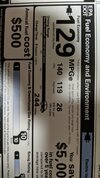I have a MY standard range and the EPA states that I should get 244 mi @ 260wH/mi.
However, when I check my energy graph screen, it shows that the rated wH/mi line is about 220wH/mi.
Normally, a lower 220wH/mi would mean that the car is more efficient. However, in this case it's bad for me because I'm averaging 260wH/mi. I need to get my wH/mi down to a lower 220wH/mi to be able to reach 244mi rated EPA miles.
My question is, why would the rated wH/mi show a lower value than what the EPA stated?
Does your EPA wH/mi match the rated line on the rebel graph?
My battery did degrade a little to 241 mi from 244 mi. But that doesn't account for the major discrepancy.
Thanks
However, when I check my energy graph screen, it shows that the rated wH/mi line is about 220wH/mi.
Normally, a lower 220wH/mi would mean that the car is more efficient. However, in this case it's bad for me because I'm averaging 260wH/mi. I need to get my wH/mi down to a lower 220wH/mi to be able to reach 244mi rated EPA miles.
My question is, why would the rated wH/mi show a lower value than what the EPA stated?
Does your EPA wH/mi match the rated line on the rebel graph?
My battery did degrade a little to 241 mi from 244 mi. But that doesn't account for the major discrepancy.
Thanks




